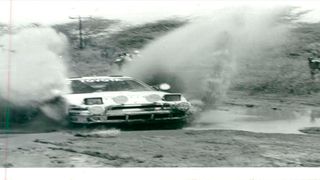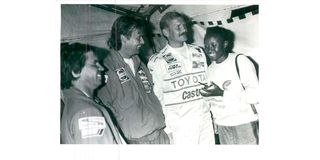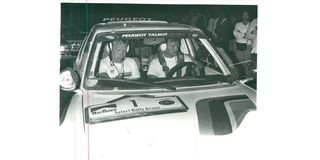
Juha Kankkunen and his co-driver Juha Piironen in Car Number 2 navigate past Loitokitok stage during the first round of Marlboro Safari Rally in this undated file photo.
Motorsport
Premium
‘Patient’ Kankkunen held nerve to win the 1985 Safari Rally
What you need to know:
- Signed in 1983 by Toyota Team Europe, he became master of endurance events in Kenya and sprinter in Europe
- In years gone by, works teams wasted no time in recruiting talent from opposition
Juha Kankkunen emerged as one of the best distance racers of his generation in the 1985 Safari Rally, pacing himself like a veteran to claim his first World Rally Championship (WRC) victory at the age of 25.
He also became the first driver to win in Kenya on his first attempt.
Kankkunen, signed in 1983 by Ove Andersson of Toyota Team Europe, ended the year with another victory in Africa after driving on the edge, matching Bjorn Waldegaard stage by stage as both ended with the same penalty time of 4 hours and 46 minutes, but the latter won the tie-breaker.
Soon, Kankunnen became the master of endurance events in Kenya and master sprinter in Europe. He won the 1991 and 1993 WRC Safari as well four world titles.
Peugeot saw a winner whom they signed immediately for the 1986 season. He quickly got accustomed to the powerful Group ‘B’ Peugeot 205 Turbo E16 Evolution 2 which he drove to victory in Sweden, Acropolis, and New Zealand to grab the championship lead over Marku Alen in a Lancia Delta S4.
The season was thrown into disarray following the painful death of Henri Toivonen and Sergio Cresto in Tour de Corse on May 2 of the same year when FIA’s forerunner FISA announced the immediate ban of the Group B powerful killers decreed as too fast to race.
A FISA investigation on possible Toivonen’s death report concluded that Group ‘B’ with a mesmerising 0-100Kph in 2.5 seconds caused tunnel vision. Drivers’ eyes were too slow to adjust their focus between fast corners, resulting in Tunnel Visions in this high acceleration.
Kankkunen was en route to an early first career WRC victory until Sanremo in Italy where stewards excluded the Peugeot in the final classification, ruling that the car’s underbody fins as illegal side skirts. Lancia and Italians celebrated an undeserved victory.
Unperturbed, the WRC headed to Olympus Rally in USA, with Alen holding a one-point lead over Kankkunen. Both gave their best but Alen proved the better driver of the day. He was finally declared the winner for 11 days but FISA overturned stewards’ decision of Sanremo following a successful appeal by Peugeot, thus handing the world title to Kankkunen.

The 1993 Winners, Juha Kankkunen (second right) and compatriot Juha Piironen (second left), talk to Nation Reporter Pamela Makotsi (right) moments after they finished the Safari Rally on April 12, 1993.
But it was in Kenya where Kankkunen exposed his inert talent in 1985, a year when all top teams trooped to Nairobi for a five-day marathon across the country.
Lancia fielded the 037 Rallye for Alen, Attilio Battega and Kenyan ace Vic Preston Junior. Audi returned with the Sport Quattros for Hannu Mikkola and Stig Blomqvist while Peugeot brought in 1983 Safari champion Ari Vatanen, Bruno Saby, and Timo Salonen.
The Toyota team of Waldegaard, Kankkunen, and Dave Horsey of Kenya was cocky having following Waldegaard’s 1984 victory in the rear-wheel-drive Celica Twincam TC Turbo. The Nissan nominated an all-Kenyans team of Shekhar Mehta, Mike Kirkland, and Jayant Shah. Opel, winners in 1983 relied on the time-tested skills of Finnish Rauno Aaltonen and German fast-rising German Erwin Weber.
This was another classical tale of the tortoise and the hare. Would the under-powered 2WD cars - Opel, Lancia, Toyota, and Nissan - keep up with the 4WD traction of Peugeot and Audi?
Mikkola and Blomqvist were dogged with underperforming 6-speed gearbox even before the cars reached Mombasa with Alen stomping into the lead through the twisty Taita Hills until a wheel came out followed by engine failure. Teammate Battega inherited the lead briefly before an electrical malfunction dropped him back.
The Peugeots were not faring better either after Vatanen dropped back with suspension problems. Salonen had the Quattro’s turbocharger changed, causing more delays.

Juha Kankkunen (right) and Juha Piironen inside their Peugeot which is Car Number 1 ready to go on the ramp for the third round of the Safari Rally in this undated file photo.
Surprisingly, Toyota, always changing the rear driveshaft as a precaution, saw Waldegaard in the lead followed by Aaltonen and Weber.
Leg two went to western Kenya and by Eldoret, Preston Junior was leading on the road but ended his race in the Kerio Valley. Mehta crashed out. Waldegaard Weber, Kankkunen and Kirkland started shinning. Rauno dropped back following a failed clutch.
As the cars headed to Nairobi Weber took the lead followed by Kankkunen but with only 300km to the finish, a loose nut from the inlet system went through the engine of Weber forcing mechanics to change the cylinder head. With Opel hopes gone Kankkunen inherited the lead again followed by Waldegaard.
Kirkland had a nasty roll but back on all the four wheels team bosses waved him on regardless, the Nissan arriving at the KICC minus the windscreen in the third position.
This rally produced expected results from the tiny Daihatsu Charades, taking 12,13th and 19th positions. Glen Mathews in a bulky Range Rovers was among 20 out of 80 starters who completed the journey.





